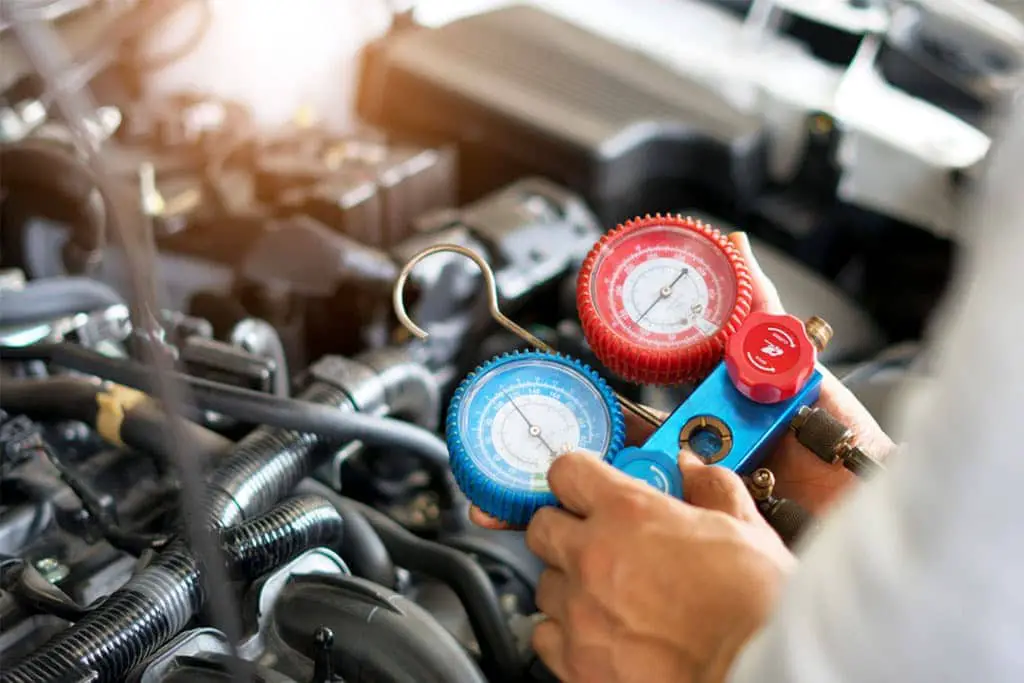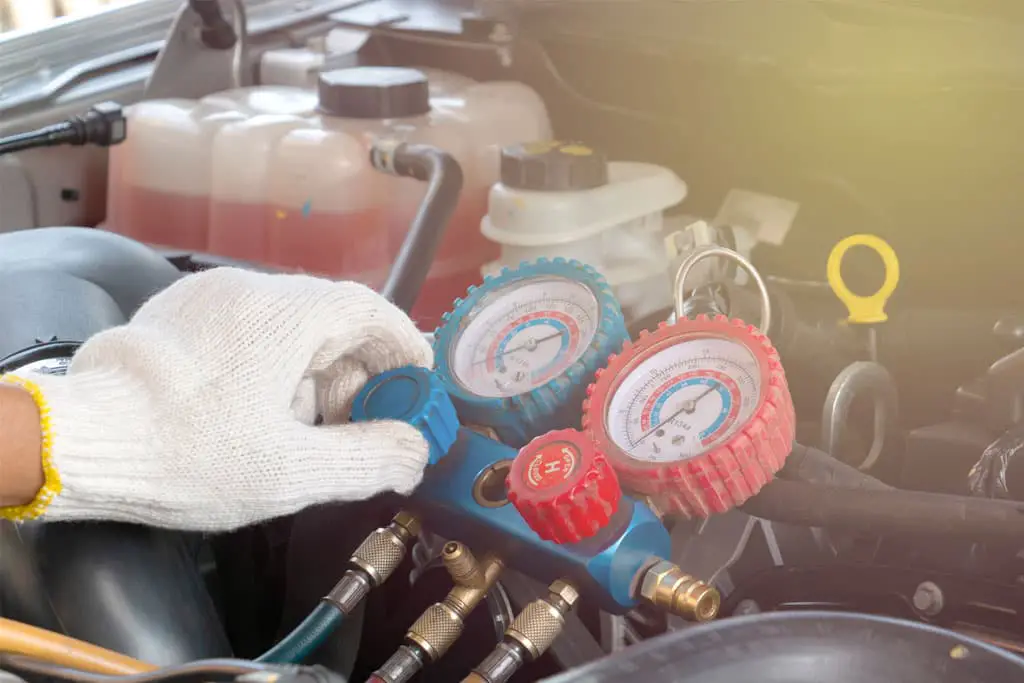If you find that your vehicle’s air conditioning is not cooling as it should or you need to know how to recharge the car AC after compressor replacement, you’re in the right place. If there is too little coolant in the system, it doesn’t perform well. Recharging the air conditioner is cheap and easy to do but it needs to be done properly. Once finished, you will have cool air flowing once again.

How AC Works
An AC system has three parts:
- Condenser
- Evaporator coil
- Compressor
They’re set up as basically two radiators in a loop with the compressor between them. The system is sealed and filled with fluid called ‘Freon‘. The compressor takes the fluid and compresses it, creating heat. Heat goes to the outside and the liquid refrigerant goes to the evaporator where it expands and cools. The fan blows the air over the evaporator and into the car, keeping you cool.
Pro Tip – ChrisFix made a detailed Youtube video showing this process. So if you get stuck, be sure to watch it below.Getting Organized
Before we get started, note that this process is meant for cars built after 1994. You need two 12oz cans of AC refrigerant, one dispenser, and safety goggles. Make sure the refrigerant is not some weird concoction that has leak sealants and enhancers. Go with the basics so you are not adding unnecessary chemicals. These additives in some types of refrigerant are not always safe for your AC system. Also, make sure the dispenser has a pressure gauge and trigger.
Put the Dispenser Together
For safety, you should wear goggles throughout the whole process. Place the can of refrigerant in the base of the dispenser, making sure it is screwed in the whole way. There is a needle in the dispenser that pokes through when you do this.
Getting Ready to go
- Start the engine.
- Turn on the ac unit.
- Put the fan onto the highest it will go.
- Pop the hood.
- Trace the hose that goes from the low side fill port to the compressor. It is usually on the left side of the engine bay and has a small plastic lid with an L on it. Open the cap to see the port. It is often a section of metal pipes with the hose coming from either end. Do not touch the high-pressure side hoses. These are small hoses and they will be hot.
- Find the pulley that is on the compressor.
- Make sure the middle of the pulley is turning. If it is then the compressor is doing what it’s supposed to. If it is not, you need to put in half of a can of R-1234a as outlined in the next steps. If the compressor still does not go, you may need a mechanic.
- While the engine runs and the AC is on max, do the entire filling regimen.
Filling Routine
Once these steps are done, move into this next section fairly quickly so make sure you read through them first so you know what to do. The dispenser should be connected at the end of the hose.
- Take the outer sleeve of the connector and lift it.
- Squeeze the trigger for at least two seconds so you can get rid of any air in the hose.
- Lift the sleeve while squeezing the trigger
- Put the connector tight on the fill port.
- Let go of the outer sleeve of the connector and then the connector, too.
- Let go of the trigger.
- Make sure the connector is on properly and seated on the port.
Keep the trigger squeezed to make sure the AC refrigerant is constant as it will keep outside air and moisture out of the system.
Recharge
- Know the right pressure to fill to using the table that comes with your dispenser. It tells you the minimum and maximum pressure that is ok for the outdoor temperature. Some gauges show a “V” that is adjustable and shows a good pressure range. Set the range that you need.
- Read the pressure. If it is below the minimum pressure, start filling the system.
- Pull the trigger for five to 10 seconds while you slowly tip and shake the can. Do not put the can upside down.
- Wait 30 seconds for the pressure to equalize.
- Check the pressure gauge again. Only do this measurement when the compressor is going. If it is still low, add more refrigerant.
- Stop filling when you get to the right pressure range.
- Do a final pressure check and put the cover back on the fill port.
Here’s a quality Freon/Refrigerant AC recharge kit
No products found.
Do not overfill
If the can empties before you are done filling, turn the empty can upside down, pull the trigger for at least 30 seconds, then let the trigger go. Take the can off the dispenser and put a new one on. Keep the dispenser on the fill port while emptying the can unless you are completely done.
When you are done, leave the extra refrigerant in the can, attached to the dispenser. Make sure you keep it out of the heat.
Final Thoughts
Now your car’s air conditioning should be nice and cold. If it does not work, check the needle on the gauge because it takes a lot of time for the refrigerant to rise in pressure. Make sure the dispenser is connected properly as well. If you put in too much, you are going to need a mechanic to fix it as you can not let out the refrigerant into the air since this is illegal. If the compressor is not engaging, do not add more refrigerant. Look at a compressor issue that maybe occurred when you replaced it.
While these steps explain how to recharge the car AC after compressor replacement, you need to be sure you are comfortable doing it. If not, do not risk it and take it to a professional. You do not want to do any damage.
If you’re still having problems with your air conditioning system, check out our A/C troubleshooting guides:

